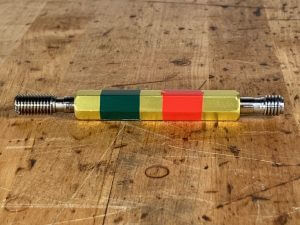Stop Spinning Gages
“I just want to avoid spinning gages all day.”
We hear this sentiment from manufacturing professionals all over the world. We were discussing this recently with a manufacturer in Wisconsin who machines large quantities of threaded parts. Their customer requires them to “GO” and “NO GO” verify every part. They were dealing with this requirement the way many plants do: operators stood by and spun a gage into every thread with their fingers. Unfortunately, this method was not only burdensome, but it allowed plenty of room for operator error and repetitive motion injury.
Our mission at New Vista is to work with manufacturers like you to provide the knowledge and tools you need to overcome thread quality obstacles so that you can stop spinning gages with your fingers. This series, as part of that mission, presents an introduction to thread gaging.
Attribute Gaging vs Direct Measurement:
When it comes to production inspection of threads, there are two types of inspection to consider: attribute gaging and direct measurement. Attribute gaging ensures that a feature dimensionally falls within accepted pass/fail range, by means of a gage. Direct measuring actually measures the feature, to determine where it is within the acceptable range. For most threaded parts manufacturing, attribute gaging is the more practical verification method due to its speed, simplicity, and low cost (especially in the case of internal threads).
Contact vs Non-Contact Gaging:

Gaging threads is a contact inspection procedure. While non-contact methods of inspecting threads exist, the traditional “GO” inspection method with a physical gage is preferable to guarantee assemblability (that is, to make sure that the thread will assemble properly with the mating part). Thread gages for straight threads (the common metric & unified standard) are usually supplied as a “GO” & “NO GO” gage set with a handle as shown here:
Pipe threads and other specialty threads entail unique gaging procedures that we will cover in the next feature. The most common types of thread checks for straight thread are “GO” verification for pitch diameter and verification of the minimum thread length. For the vast majority of manufacturers, employing these two verifications at 100% is sufficient. When “NO GO” gaging is employed it is typically only sampled, not checked 100% of the time.
“GO” Checks:
“GO” gaging, by its nature, is a composite check; it verifies for several attributes all at once, and, through that composite verification, it guarantees assemblability. So, a “GO” gage for an internal thread would guarantee that the thread’s pitch diameter, the minor diameter and the major diameter are all sufficiently large. If the gage is employed advantageously, it will also guarantee that the thread is of sufficient length (depth).
“NO GO” Checks:
“NO GO” gaging, except in rare instances, can only ever check for one attribute at a time. Manufacturers may be required to “NO GO” verify a thread’s pitch diameter or minor diameter. In either case, the “NO GO” gage ensures that the pitch or minor diameter is not oversized which would cause the mating part to be loose. Standards differ depending on part material, thread size and thread length, but the general rule of thumb is that the “NO GO” pitch diameter gage should not go more than 2-3 turns into the thread. Be sure to review your thread’s particular specifications. A “NO GO” minor diameter gage is as simple as using a gage pin or gage ball to ensure that it does not enter the thread.
In situations where both “GO” and “NO GO” verification is required, New Vista has developed combination gages that will perform both checks in one pass on thru threads, saving time and costs.
In Summary:
The “GO” and the “NO GO” checks are a critical aspect of any manufacturing process involving threads, but you don’t have to do them with your fingers. If you would like to find out how you can expedite your thread inspection process, or if you have additional questions about thread gaging, contact one of New Vista’s Applications Engineers today. Expert applications service is available from our U.S. location and in several other countries as well.
